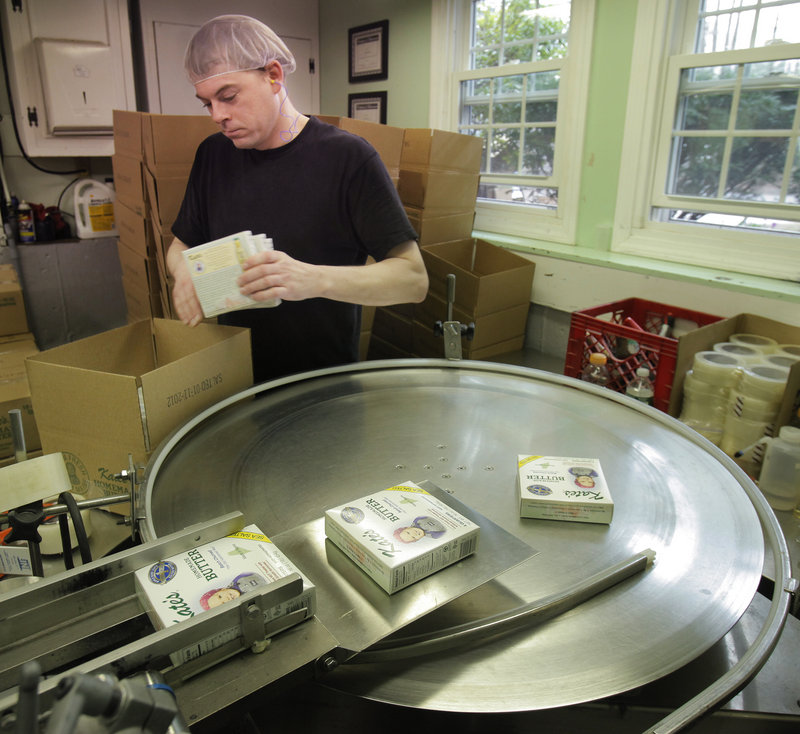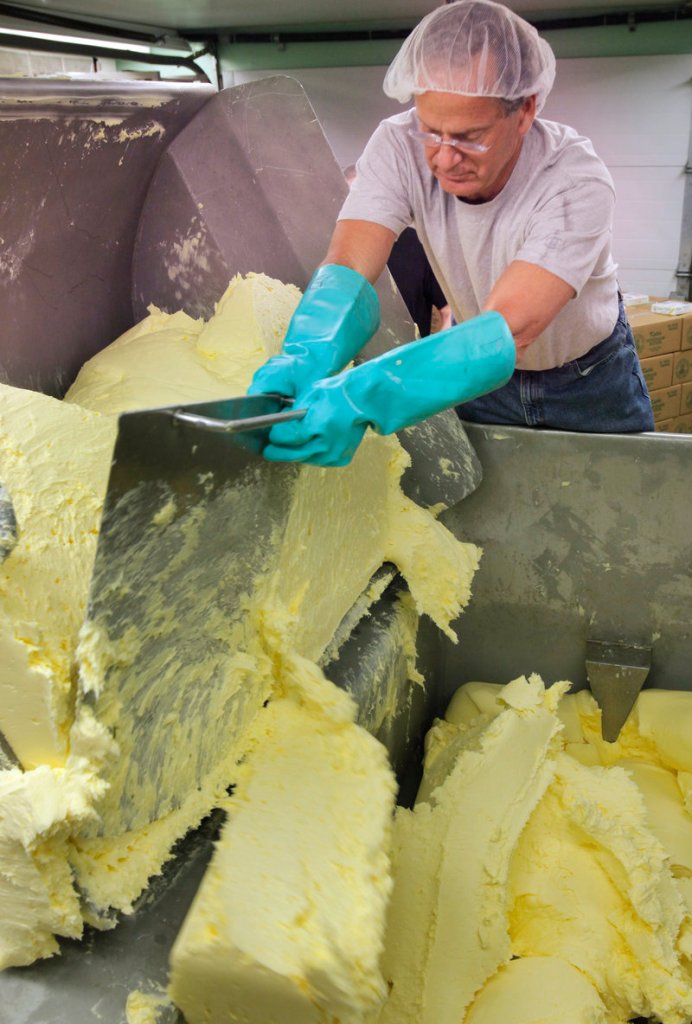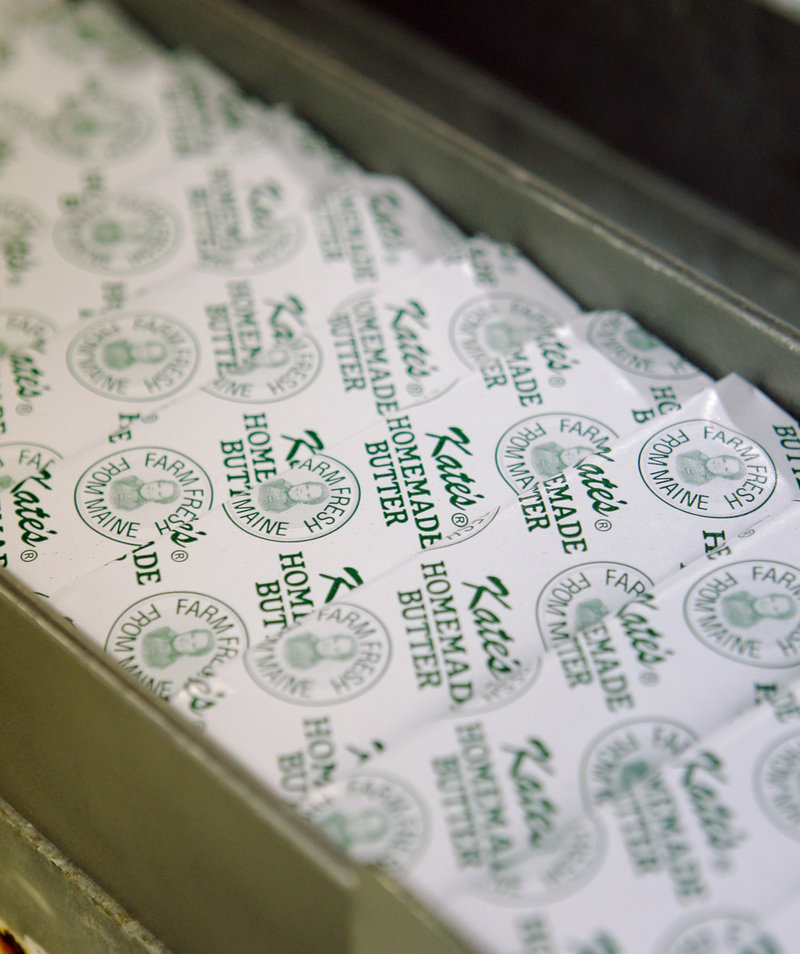OLD ORCHARD BEACH – You wouldn’t expect to find a dairy company on Arbutus Avenue in Old Orchard Beach.
The lane runs though a dense, tree-lined residential neighborhood.
But from the basement and garage of one unassuming split-level home, Daniel Patry and his family operate Kate’s Homemade Butter, a small company competing in an industry dominated by big business.
Now in its third decade, Kate’s makes millions of pounds of butter yearly and ships products to retailers in New England and beyond. And next year, the company, which has six staffers, will relocate to a new 17,000-square-foot production facility and may begin making other dairy products.
Patry, a longtime dairyman, says long hours, passion for butter making and a quest for perfection are keys to Kate’s success.
“Unless you love it, you will never make it,” said Patry of the business. “It’s extremely tedious (work).”
Patry, who is a former Oakhurst Dairy salesman, and his wife, Karen, launched Kate’s in their garage in 1981.
They named their company after Patry’s niece Katie, now 32, whose picture is on the logo.
“I’ve got three boys, and we wanted to put a girl on the package,” Patry explained.
To this day, it’s hard to find Kate’s production house on Arbutus. There’s no sign. No loading dock.
But outside one home are clues: A few pallets. A dolly. A couple of hand-operated fork lifts.
Peer into the garage window, and you’ll see a compact and bustling manufacturing plant with stainless steel tanks, a rotating churn and packaging machines. The production line snakes from the garage and into the basement.
On butter-making days, Patry, who lives in another home in Old Orchard Beach, arrives at the production site at 1 a.m.
Starting early leaves a margin of error: If his equipment breaks down, he has time to make repairs before the end of the business day.
After hosing down the plant — Patry’s first chore — he pumps some 1,000 gallons of cream into a 10-foot-high, 1960s-era churn, which looks like a flying saucer stood on edge. Kate’s cream comes from dairies throughout northern New England, including Oakhurst.
The churn spins like a clothes drier for nearly two hours until the solids in the cream separate into several thousand pounds of butter.
Next, Patry rolls a bathtub-size “butter boat” into the front of the churn. He hits the “on” switch for a split second, rotating the churn and dumping a load of soft, yellow butter into the boat.
Patry then dumps the load into a silo, where it is pumped to packaging machines.
Kate’s makes roughly 15,000 pounds of butter in one production shift, which can last 20 hours.
There are three butter production shifts weekly, and one day weekly is reserved for making buttermilk.
Kate’s products are sold in major New England supermarkets like Hannaford Bros., Stop & Shop and Shaw’s. High-end food retailers and distributors like Massachusetts-based Roche Bros. and New York-based Nassau Candy also carry Kate’s, as do stores in Chicago and as far west as Las Vegas.
The company has yearly revenue topping $3 million and six employees, including Patry’s nephew, 35-year-old Tim Heffernan, and his 29-year-old son Luke, who joined Kate’s full-time a few years ago.
At Luke’s urging, Kate’s upgraded some of its equipment in recent years, which has allowed the company to expand production.
Next year, Kate’s will start making butter at a new, 17,000- square-foot plant on a 40-acre plot off Route 111 in Arundel. Patry said the move will let Kate’s make more butter and branch out into other dairy products.
There is even talk of having a herd of roughly 25 milking cows.
Brad Legreid, executive director of the Wisconsin Dairy Products Association, said Kate’s is one of very few small butter makers thriving in the industry.
He said that in the last 20 years, following retail industry trends, the dairy industry consolidated under a handful of large dairy producers, including Minnesota-based Land O’Lakes and Associated Milk Producers Inc., and O-AT-KA Milk Products Cooperative in Batavia, N.Y.
“There aren’t too many butter manufacturers left in the U.S.,” he said.
Patry said startup costs can be prohibitive to small butter companies. His equipment — the churn, pumps, pipes, tanks and machines — cost millions of dollars. The pasteurizer alone cost $500,000.
Patry said he trimmed expenses by financing some of the equipment directly with the manufacturer, not through banks.
Still, Kate’s costs more money to make. And consumers pay more for Kate’s than they would for many other butters.
But Patry said his product is superior.
He said Kate’s uses sea salt and Food and Drug Administration grade A cream. And his butter is wrapped in foil, which is three or four times the price of parchment paper, but absorbs less odor.
Patry said Kate’s small-batch process allows him to monitor production and catch potential problems early.
The result, he said, is a clean, fresh butter that isn’t greasy.
“When it melts,” he said, “it doesn’t leave an aftertaste in your mouth.”
And while other companies’ buttermilk is a mixture of skim milk and buttermilk cultures, Patry said Kate’s is the real deal — the liquid by-product of butter making.
Kate’s won first place in the unsalted butter category at the Madison, Wis., World Dairy Expo in 2008, and third place in the salted and unsalted categories in 2010.
Kate’s buttermilk took home the first place prize in the creative and innovative category in 2009.
Legreid, at the Wisconsin Dairy Products Association, called the awards a big deal for a small company.
Kate’s competed against roughly 20 other companies in the butter category, including the industry’s major corporate players.
Products were rated on a variety of factors, including texture, taste and appearance, by a panel of about 30 judges, some of them U.S. Department of Agriculture staff and university professors.
“These are people who know what dairy products should taste like,” Legreid said
He added that a World Dairy Expo award can help small companies compete.
“If they win, it’s a huge marketing blitz. It’s a tremendous boon for these (small) companies because it gives (them) a huge jump-start,” said Legreid.
Other than a note on Kate’s packages, Patry hasn’t promoted the award.
And though he expects the company will continue to expand, he hasn’t set firm growth goals.
His first priority, he said, is to enjoy his work.
“We want growth … but it’s not like we must sell 10 million pounds a year,” he said. “You have to make money, but you also have to like what you do.”
Jonathan Hemmerdinger can be reached at 791-6316 or:
jhemmerdinger@mainetoday.com
Send questions/comments to the editors.




